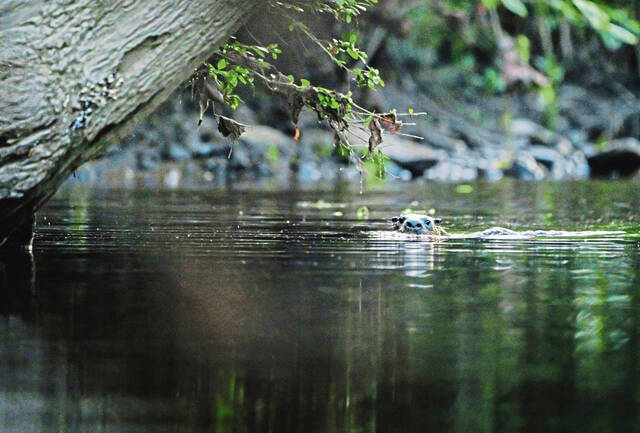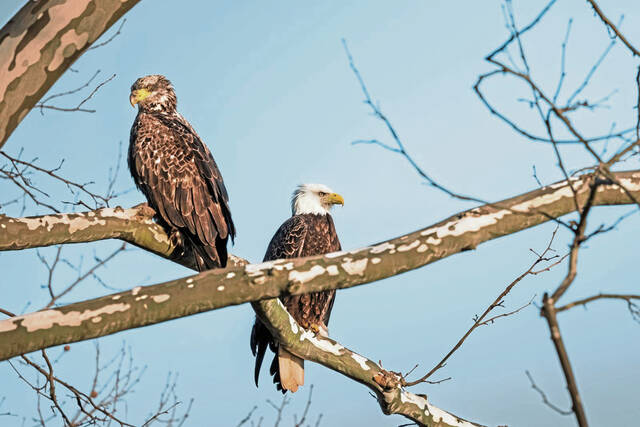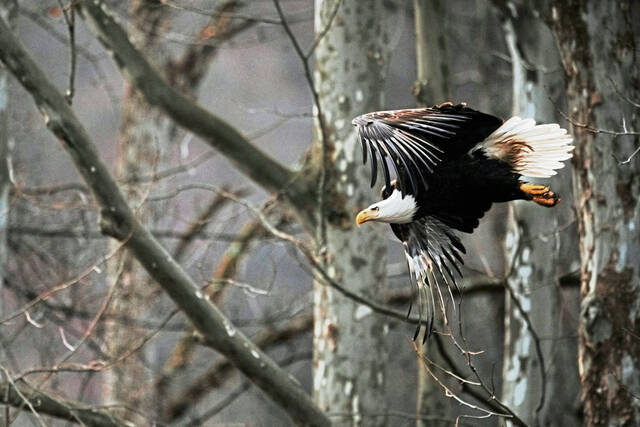Otter, eagle sightings along Loyalhanna bode well for healthy creek habitat
Hempfield photographer Kyle Rose enjoyed a double dose of excitement on the Fourth of July.
On a trip to the Ligonier area with his family to see a later fireworks display, he came upon another amazing sight: an otter swimming in nearby Loyalhanna Creek.
“It was awesome,” said Rose, who went to extremes to capture an image of the creature. “Nobody has documented one of them being in the Loyalhanna before.”
This past summer, reports of otter sightings began filtering in from people fishing along the creek near Ligonier to officials with the Loyalhanna Watershed Association and the Pennsylvania Game Commission.
“The sighting of at least one pair of unexpected North American river otters has taken us all by surprise,” said a delighted Susan Huba, executive director of the watershed association.
That’s because, in the face of human encroachment and unregulated trapping and habitat pollution in the past, the fur-bearing mammals had disappeared from Western Pennsylvania and many other areas of the state by the early 1900s. The Loyalhanna was not among waterways included in more recent efforts to reintroduce the species.
Learning of the otter sightings, Rose set out to find and photograph them. He sought clues from Loyalhanna anglers and, for several weeks, kept watch for the elusive animals at various points along the creek.
“I wasn’t finding anything,” he said. “It was like I was looking for Bigfoot.”
On the July 4 trip with his wife and kids, as their car traveled along Ligonier Township’s Two Mile Run Road, Rose “turned my head and saw a brown lump rolling in the water. I knew exactly what that was, and I said to my wife, ‘Stop the car!’ ”
Eager to get the otter into focus before it vanished from sight, Rose grabbed his ever-present camera and slid down a hillside into the creek — regardless of getting his shoes and pants soaked.
“I got down in the creek,” he said. “Sure enough, there (the otter) was, with his nose up.
“I was probably between 50 and 70 yards away. He swam around and dipped under the water and away he went.”
Uploading the resulting photos to an iPad, Rose found he’d captured some shots of the otter looking head-on at his camera.
It was a thrilling moment for Rose that combined his passions for photography and wildlife.
“I used to fall asleep to National Geographic documentaries,” said Rose, who has a degree in biology. “I knew I wanted to work with animals, I just didn’t know in what capacity it would be.”
Rose is assuming the otter he photographed was an adult male, as that gender of the species typically roams on its own when not seeking a mate.
Other Loyalhanna observers have reported seeing two small otters in the company of a larger one, which could be a mother with its offspring.
River otters can bear their young anytime from November through May, according to Tammy Colt, regional wildlife recovery biologist for the Game Commission’s Southwest Region and a Loyalhanna Watershed Association board member.
“Litter sizes can be anywhere from one to six,” said Samara Trusso. wildlife management supervisor for the Game Commission’s Southwest Region. “The average is about three.
“The males don’t have as much to do with rearing the young.”
As noted on the Game Commission website, adult otters are about 30 to 40 inches long, with a tail that stretches for about another foot. Females are roughly 25% smaller.
They have webbed feet for swimming and, like other members of the weasel family, musk glands that release a pungent odor when they’re frightened.
Otters are terrific swimmers, able to propel themselves through the water at up to 7 mph. They can swim underwater for up to a quarter-mile without coming up for air, thanks to valve-like structures that seal off their ears and nose.
These muscular mammals can put up a fierce fight when cornered. When unmolested, they display a playful nature.
“In the winter, they slide on their bellies into the water,” Colt said. “They do seem to play.”
Since otters aren’t being tracked locally by the Game Commission, officials can only speculate that the ones sighted in the Loyalhanna may have migrated from the Conemaugh River, which joins with the creek downstream to form the Kiskiminetas River.
“They have cropped up in the Conemaugh watershed,” Colt said of river otters. “We know they’ve been there a while.”
Or they may have wandered over from the Youghiogheny River watershed, where 28 otters were reintroduced since 1990.
Bald eagles also a welcome sight
All agree that the appearance of the otters is a good sign for the Loyalhanna. It means efforts to combat erosion and clean up pollutants such as mine drainage have been successful in restoring a stream habitat that can support the fish that are an important food source for otters and another increasingly seen species along the creek — the bald eagle.
“Thanks to the work of our organization and other conservation partners in our watershed, our streams support a healthy and diverse fish population,” said Huba. “In turn, there are several pairs of nesting bald eagles that have taken residence along the Loyalhanna’s banks. Blue heron rookeries have popped up in tall sycamore trees in former industrial areas along the same waterway.”
Rose has photographed several bald eagles along the Loyalhanna, including some juvenile birds that had yet to develop the species’ distinctive white head coloring. He’s captured some of those images near Kingston Dam, at the border of Unity and Derry townships.
“I found my first bald eagle three years ago as I was driving toward Ligonier from Latrobe at 8:30 in the morning,” Rose said. “At first I assumed it was a turkey vulture flying over my car, but I realized it wasn’t the right shape.
“Then I got a glimpse of the head. My brain just exploded.”
Unlike bald eagles, river otters as a species lack protected status. While immature otters might fall prey to coyotes, foxes or bobcats, humans are the only known predators for adult otters, Colt said.
Limited trapping of otters is allowed in some areas of Pennsylvania’s northern tier, she said, but the species’ numbers are too small to permit any trapping in the Game Commission’s Wildlife Management Unit 2C — a 2,900-square-mile area encompassing all of Somerset County, large sections of Westmoreland and Fayette counties and smaller portions of Cambria and Bedford counties.
Time will tell whether otters become a more frequent sight on the Loyalhanna.
Recent sparse rainfall has diminished the water level of the creek near Ligonier, which Colt said may have decreased the aquatic food that is available, prompting the otters to move elsewhere.
“I’m blessed that I was able to find an otter and capture it with my camera,” said Rose. “It’s a special sort of feeling.
“I hope they’re left alone to exist happily.”
For those who view his photo of the otter, he said, “I hope it gives people a better sense of how precious of a resource that water is.”
Jeff Himler is a TribLive reporter covering Greater Latrobe, Ligonier Valley, Mt. Pleasant Area and Derry Area school districts and their communities. He also reports on transportation issues. A journalist for more than three decades, he enjoys delving into local history. He can be reached at jhimler@triblive.com.
Remove the ads from your TribLIVE reading experience but still support the journalists who create the content with TribLIVE Ad-Free.



